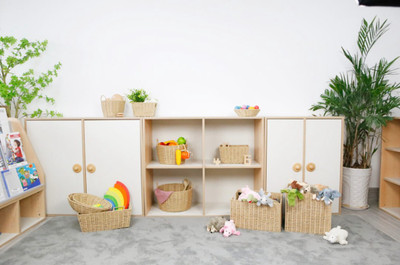Want Better Play? Try Toy Organisation
Sep 18, 2025
If you’ve ever stepped on a stray block or stared at a room overflowing with toys while your child still says, “I’m bored,” you’re not alone. Toy clutter is common in every home, but toy organisation can change everything. When toys are arranged and easy to find, play becomes calmer, more creative, and far more meaningful.
Why Toy Organisation Matters
Toy organisation is not just about keeping the house neat. It actually changes the way children play and learn. A well-arranged play space helps kids focus on one activity at a time, reduces overwhelm, and even encourages longer stretches of independent play. It also gives children the chance to practise responsibility by caring for their belongings.
According to Raising Children Network, toddlers aged 2-3 feel more confident and independent when they are given consistent opportunities to help with everyday tasks around the home, such as putting toys away.

Keep It Simple: Less Is More
It is tempting to think kids need lots of options, but too many choices can be overwhelming. In fact, fewer toys often mean richer and deeper play. That is where toy rotation comes in. Keep a small selection of toys accessible and pack away the rest. Every few weeks, swap them around to make old favourites feel new again.
Quality also matters more than quantity. Open-ended toys such as building blocks, rainbow stackers, or play silks can be used in countless ways. These toys keep kids engaged without adding clutter. For example, the Vivaio Wooden Arch Stacker can become a tunnel, bridge, or tower depending on a child’s imagination.

Practical Storage Ideas for Toy Organisation
The way toys are stored makes a huge difference in how children interact with them. Declutter expert, Steph Pase, suggests that categorising toys and giving each type a clear home reduces chaos and helps children actually use what they have. You can try using:
- Low shelves at a child’s eye level encourage independence. A simple wooden toy shelf helps kids see their choices and return items easily.
- Baskets and trays group similar items together. Blocks, cars, or animal figurines are far more inviting when presented neatly than when buried in a toy box.
- Clear containers for toy organisation work best for puzzles and small pieces. Kids can see what is inside without dumping everything out.

Designing a Play Space That Inspires
Beyond storage, the overall layout of a play space can shape the way children use it. Think of the play area as an invitation. When toys are displayed in an ordered and beautiful way, children naturally want to engage.
Create defined areas such as a reading corner, a building space, and an art table. Play then feels purposeful.
Leave room for movement. Too much furniture or clutter makes it harder for kids to play freely.
Choose calming colours and natural materials. Wooden shelves, woven baskets, and neutral tones can create a sense of peace.
Research influenced by the Reggio Emilia philosophy and highlighted by ACEQUA emphasises that the environment acts as a ‘third teacher.’ It supports children’s learning just as much as adults and peers do.

Teaching Kids to Care for Their Toys
Toy organisation also teaches children valuable life skills. When clean-up becomes part of play, kids learn responsibility and respect for their things. Try these simple strategies:
- Label baskets with words or pictures so younger children know where everything goes.
- Play a tidy-up song to make cleaning fun.
- Keep the routine consistent. If toys come out, they go back before the next activity begins.
A calm, organised play space does not have to look like a Pinterest board. It just needs to invite your child to explore, imagine, and enjoy without being overwhelmed. Start small, focus on making toys accessible and easy to put away, and involve your child in the process.
Want to create a play space that works better for your family? Check out our range of children's storage furniture & shelving and loose parts storage & display for toy organisation.


